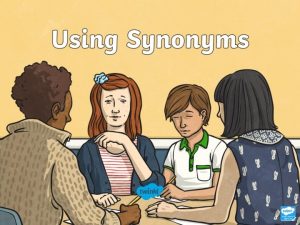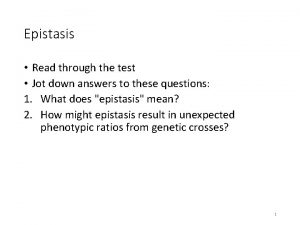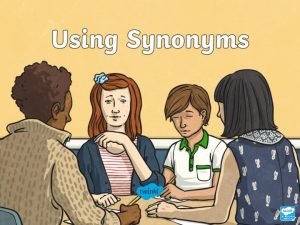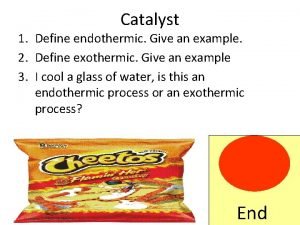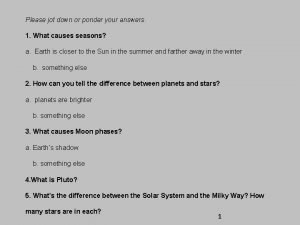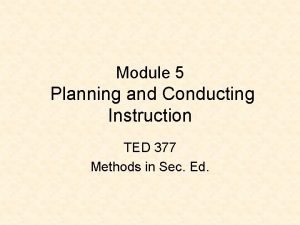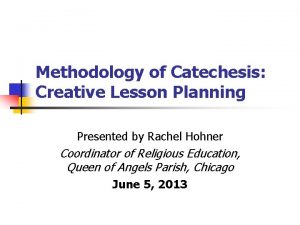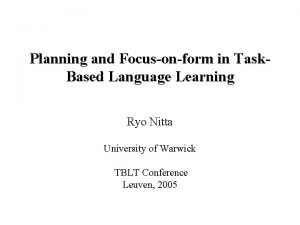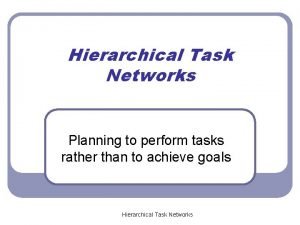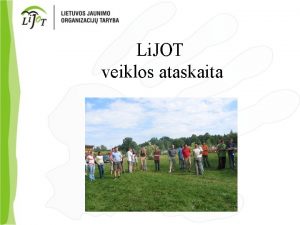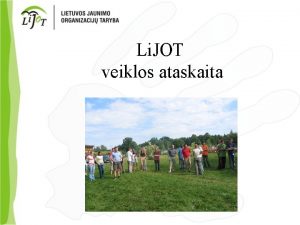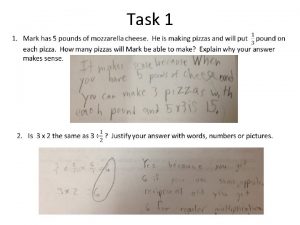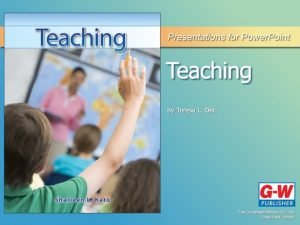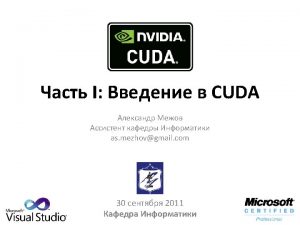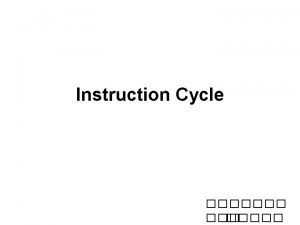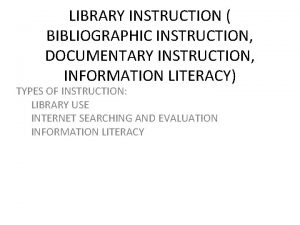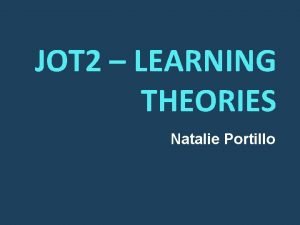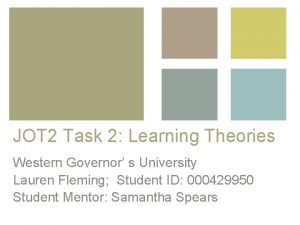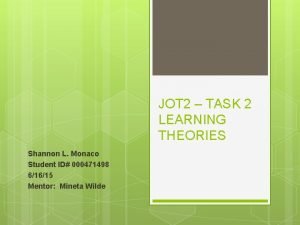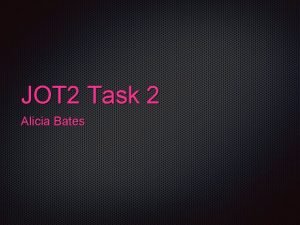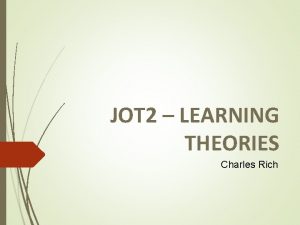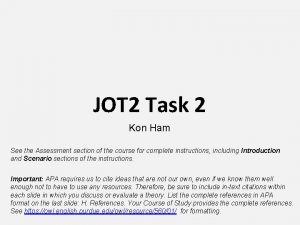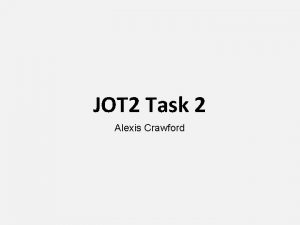JOT Task 2 Planning of Instruction JOT 2

















- Slides: 17

JOT Task 2: Planning of Instruction JOT 2 Task 2 Planning of Instruction Yuriy Bilokonsky Western Governors University 001108338 Jeni Clark 10/17/2020

Overview of Learning Theories • Behaviorism – Focuses on improving the form or frequency of observable performance. The goal is on associating stimulus and response. A stimulus elicits a response and correct responses are rewarded. • Cognitivism - Focuses on development of cognitive processes. Students are encouraged to interact with the system of instruction. • Constructivism – Focuses on mapping the structure of the world onto the learner. Knowledge is seen as being rooted in how the learner manifests meaning from experience.

Behaviorism • • Teacher centered Set correct response Shaping behavior to match correct response Learning comes from reinforcement of correct feedback by instructor Good for rote memorization of facts and for developing routines (Ertmer & Newby, 2017)

Cognitivism • Teacher Centered • Communication based • Builds upon a foundation of knowledge Good for teaching new material to students and providing a structure to a student’s learning. (Ertmer & Newby, 2017)

Constructivism • • Learner focused Develops from interactions between students No set right answer Learning depends upon the process of students experiencing lessons • Each student constructs their own understanding Good for developing collaborative skills and discovering new concepts (Ertmer & Newby, 2017)

Lesson Plan Grade: 7 th Subject: Standard: Students will be comfortable conducting and receiving interviews Objectives: Students will create interview questions to ask one another as if on a talkshow in English. Students will be able to both ask and answer questions in a conversational manner. Materials: Videos of interviews, notebook paper, pens and pencils. English Interview Vocabulary: accomplishment, interest, goal, talent

Procedure 1. Students are broken into groups of three or four. 2. Students watch samples of interviews. s: Time: ~20 minutes 3. Class discusses the sorts of questions asked in interviews and how they show the personalities and characteristics of the interviewer and interviewee. 4. Students decide who within their group will interview whom. Guided Practice: 1. Teacher goes among the students, checking their progress ~20 minutes and understanding of the assignment and helping them to brainstorm and rehearse questions and answers. 2. Students write down questions and answers. Performanc e: 1. Each group will perform their interviews, with two members ~10 minutes in front of the class without their scripts. They are encouraged to go off book and speak naturally. If they become confused, the other members of the group are allowed to cue them from the script. 2. Those who do not have a chance to perform this period will perform the next.

• This lesson uses constructivism as its Learning Theory Used basis, as the students are encouraged to work together to form meaning from the sample interviews and through the construction of their own versions of an interview. • The teacher provides guidance in how to accomplish the task, but does not offer an ideal format or requirements for the students to conform to.

• This lesson could use the cognitive learning theory. • The students could be given sample Adaptatio n questions and answers and memorize the forms of these questions and answers to fill in with their own information. In this case it would not be a group assignment, but instead the students would spend the class memorizing and at the end of the class a game would be played in which the students are asked a question to which they “buzz” in with an answer in the correct format.

Preferred Lesson Plan • With the goal of valuing production of language over repetition of it, the constructivist approach is superior. • It allows the students to work together to form an understanding of the situation and is more free-form, inviting humor from the students and making the environment more fun. • It also reinforces the idea that the function of the language is more important than the form, so that the students, rather than learning to wrack their brains searching for the correct sentence format with the correct information in it, learn to create new sentences on the fly.

Theories of Design • Gagne’s Nine Events of Instruction: Gain Attention, Inform the Learner of the Objective, Stimulate Recall of Prior Knowledge, Present Stimulus Material, Provide Guidance, Elicit Performance, Provide Feedback, Assess Performance, Enhance Retention and Transfer (Curry, Johnson, & Peacock, 1970) • Wiggin’s Theory of Backward Design: Identify Desired Results, Determine Acceptable Evidence, Plan Learning Experiences and Instruction (Kurt, 2018) • Elements of Teaching for Understanding Generative Topics, Understanding Goals, Performances of Understanding, Ongoing Assessment (Fusaro, 2008)

Benefits Provided by Theories • Provides a set of parameters for designing lessons • Helps the lesson designer to factor in the widest variety of learners • Give learners clear goals and expectations • Increases the relevancy of the lesson activities

Gagne’s Nine Events Strengths: Weaknesses: 1. The scaffolding process provides a 1. Students are not interacted with as 2. Teacher has direction of the 2. Nine steps become monotonous 3. Requires a lot of effort from both structure that requires students to master subject matter as they progress process 3. Students receive guidance and feedback as the lesson progresses 4. The focus is on real-world application individuals teachers and students (Curry, Johnson, & Peacock, 1970)

Wiggin’s Theory of Backward Design Strengths: 1. Makes the planning process more obvious because you start from the goal 2. Makes the assessment of students more obvious 3. Provides more novelty for students Weaknesses: 1. Requires a larger investment of time into the planning process 2. Does not take the students autonomy into account 3. More test oriented than other approaches (Kurt, 2018)

Elements of Teaching For Understanding Strengths: Weaknesses: 1. Multiple modes of accessibility 2. Connects the subject matter to 1. Slow progression 2. Adjustments to the plan could 3. Provides engagement to both 3. Not useful for preparing large the students lives students and teachers 4. Focuses on central ideas to a given discipline or subject area cause it to fall apart numbers of students for standardized tests. (Fusaro, 2008)

Justification of the Most Appropriate Design Theory for My Setting • The Elements of Teaching For Understanding is the most appropriate design theory for this lesson. • The central discipline addressed is the production of English and it is done in a way that fosters both identity and creativity in the students. • The students are able to come up with questions and answers on their own, which not only makes the lesson more engaging to everyone, but also provides accessibility to multiple ways of thinking and interacting. • It is designed to provide feedback and information to the students as they put together their questions and answers for one another and themselves.

References • Curry, J. H. , Johnson, S. , & Peacock, R. (1970, January 01). Robert Gagné and the Systematic Design of Instruction. Retrieved October 23, 2020, from https: //edtechbooks. org/id/robert_gagn_and_systematic_design • Kurt, S. (2018, September 21). Backward Design. Retrieved October 23, 2020, from https: //educationaltechnology. net/backward-design-understanding-bydesign/ • Fusaro, M. (2008, May 29). What is Teaching for Understanding? Retrieved October 23, 2020, from https: //www. gse. harvard. edu/news/uk/08/05/whatteaching-understanding • Ertmer, P. , & Newby, T. (2017, January 01). Behaviorism, Cognitivism, Constructivism. Retrieved October 22, 2020, from https: //lidtfoundations. pressbooks. com/chapter/behaviorism-cognitivismconstructivism/
 Kategorie jot
Kategorie jot Jot down synonym
Jot down synonym Recessive epistasis in mice
Recessive epistasis in mice Jot down synonym
Jot down synonym Define endothermic
Define endothermic Jot air balloon
Jot air balloon Please jot down
Please jot down § 367 abgb
§ 367 abgb Differentiated instruction vs individualized instruction
Differentiated instruction vs individualized instruction Tiered task bias task
Tiered task bias task Planning and conducting instruction in the classroom
Planning and conducting instruction in the classroom Catechetical instruction lesson planning
Catechetical instruction lesson planning Exploring online planning and task management
Exploring online planning and task management Task based planning
Task based planning Hierarchical task network planning
Hierarchical task network planning Short, medium and long term planning in education
Short, medium and long term planning in education Role segmentation workforce planning
Role segmentation workforce planning Language policy and planning ppt
Language policy and planning ppt

